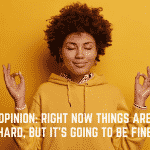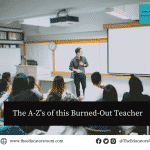I’m writing this while sitting up in bed, trying to rest and relax 48 hours after a positive COVID test.
Yes, I was vaccinated. Yes, I was boosted. Yes, I wore a mask while out in public most of the time.
And no, I probably didn’t get it during the first day of school. Considering Omicron’s shortened incubation period, I probably got it a couple of days before school started, just in time for me to teach for two days of a new semester before I crashed into bed to take one of the at-home tests that we still had in our bathroom.
Ten minutes later, my worst fears were confirmed. I am now banished to my bedroom while my husband and kids do everything they can to avoid me and make sure that my needs are taken care of, desperately hoping that they will not also fall ill.
Thankfully, the vaccines seem to be doing their job and I’m doing much better than I was in the first 24 hours. But that doesn’t change the fact that I’m now another statistic, another teacher out, another classroom staffed with a substitute, more of my colleagues asked to cover for my empty classroom while I sit at home recovering.
Let me be perfectly clear, teachers do not want to teach remotely. We do not want to return to the early days of the pandemic, teaching over Zoom, students not showing up for classes, students unable to complete their work because of unreliable equipment, ourselves struggling to communicate with other human beings through words, and images on a computer screen.
But our current national situation is just not sustainable.
We are not reaching crisis mode. We were in crisis mode years ago. We were in crisis mode before COVID-19 reached our shores. We were in crisis mode before schools shut down across the country.
We were in a crisis mode because our school systems weren’t built to handle sickness.
Before the 21st century, there was no feasible way for our schools to operate during times of illness. For many of us, illness meant our parents had to collect books and workbooks from our teachers and we had to attempt homework completion at home, our only guide the handwritten instructions from our teachers. We didn’t have email. We didn’t have online course management systems. Our parents weren’t calling our teachers to ask them to explain what we were missing in class. If we didn’t understand the directions in our textbook, we had to wait for our teachers to explain it all to us once we returned to school.
For better or for worse, the technology explosion of the 21st century changed all of that. With the internet, home laptops and tablets, cell phones capable of doing more than my first desktop computer, email communication, and the availability of more course management systems than most teachers know what to do with, theoretically, we should be equipped for any kind of outbreak of illness. But we learned in the spring of 2020 that there was a serious equity issue with technology too. The availability of tools didn’t necessarily translate to students and even teachers having easy access to the tools.
If anyone knows how much remote “learning” impacted students, teachers do. We know. We’ve been working through the impact of it for two years. We’ve seen the learning gaps. We’re dealing with discipline issues related to students who are struggling and frustrated. We’re constantly evaluating and reevaluating everything we are doing and whether it is helping or hurting our students.
And we don’t want to do remote instruction again.
The problem is that many in education feel like most people outside of education don’t really want to do everything necessary to keep the school in session. Instead, they want teachers and administrators to do everything they are capable of doing to keep the school in session.
If the general population was serious about in-person learning, they would be willing to spend the money on testing inside of schools so that teachers and students could be tested as soon as they exhibited symptoms. They would be willing to provide the funds for permanent smaller class sizes and staffing for those smaller classes. They would be willing to improve ventilation and air quality in all school buildings to help prevent the spread of a variety of viral infections during the winter months.
They would be scrambling to make sure that everyone who can be vaccinated against COVID and the flu and every other disease that plagues classrooms around the country every year is vaccinated against all of those diseases.
They would see masking as a simple mitigation effort that should be used during every outbreak of viral illness that can be spread in close quarters. Instead of declaring freedom against wearing masks, they would see wearing masks as a path towards freedom. They would see it as a way to keep sick people from spreading viral illnesses to other people in close quarters so that school could stay in session with the maximum number of children and teachers in the building, something that was a frequent problem even before any of us heard the words “COVID-19.”.
COVID didn’t break the system; it just showed us very clearly what was already broken.
Schools have always had to deal with outbreaks of illness that have threatened a system’s ability to effectively educate for an entire school year. As a child growing up in the 80s, I remember the year that I got chickenpox along with the majority of my kindergarten classmates. At one point, my elementary school considered shutting down for a couple of days to stop the spread of an illness that was keeping students out for weeks at a time. During the course of my career, influenza outbreaks have disrupted semester finals, strep and bronchitis have threatened play performances during the years I’ve directed, and I’ve even seen locker rooms temporarily shut down for a bizarre teenage outbreak of hand, foot, and mouth disease.
Before COVID hit, teachers were known to do everything possible to stay in the classroom. It became a twisted medal of honor to be able to say, “I taught while sick with____.” Me? For the majority of my career, I’ve taught at least a few days during the school year without a voice, whispering instructions and writing detailed directions on the board. I once taught a class period, admitted to myself that I had a fever, and then fought through the following prep period to get all of my lesson plans completed before reporting myself to the office and having my temperature taken. I was home for the next two days with the flu. I even finished my lesson plans while in labor with my first child because I went to the hospital on what was supposed to be my last day before maternity leave.
My hope was that COVID would change all of that. That we teachers would finally allow ourselves to take care of our health which would, in turn, take care of the health of our students.
If only society would allow that to happen.
What do teachers want those on the outside to understand? We want to be in school. We want to be with our students. Taking a sick day isn’t a “day off” for us. While we are trying to rest and heal, we are also sitting up in bed with laptops, answering emails, reading IEPs, grading, and entering grades, all while hoping that our students who are still in the building will actually do the work that we have left for them to do and that they will still be learning something.
We don’t want to be heroes, we just want to have our lives and health and the health and lives of all of our students be a priority to more than just us.
There are no easy answers for how to navigate all of this. But keeping kids and teachers in school is a society effort. Teachers and administrators are tired of trying to hold it all together, alone.







Oh wow! I have felt like I have been alone when it comes to my students’ learning loss! I have taught for 18 years and this is the first year that I really feel like I literally have to hold my students’ hands on just about everything. They can’t seem to do anything on their own. I feel like I am spending way more time on different areas of academics than before and I am so afraid that my students will not be ready for the next grade level. However, we will send them on anyway. I teach 4th grade and I am so tired and overwhelmed with everything! This year I have 32 students and in the past, I have had only 14-20 students depending on the year. Our district won’t hire another teacher to split the class. We need to have smaller classes so that students can get the help that they need. I do have Paras who help, but that’s just not enough. If I could retire I would. That’s how bad it is. And yes! Parents are asking for more help and cannot help their own children due to lack of their education or that it’s a two-job income and parents come home tired and need a break. I get it! We’re all suffering and I don’t have an answer.